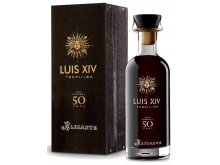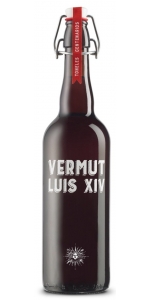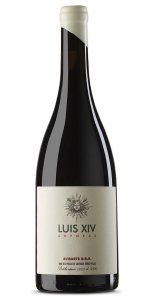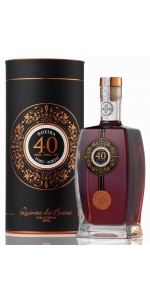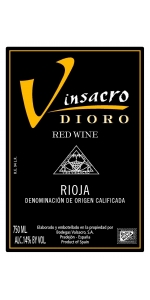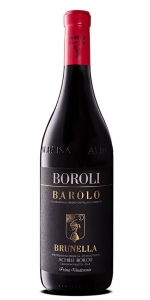Luis XIV Fondillon Oro 50 years NV (500ml)
3 bottles with free shipping for: $1,320.00
6 bottles with free shipping for: $2,550.00
| BUY MORE! SAVE MORE! | ||||||||||||||||||||
|
| Country: | Spain |
| Region: | Valencia |
| Winery: | Fondillon Luis XIV |
| Grape Type: | Mourvedre |
| Vintage: | NV |
| Bottle Size: | 500 ml |
Luis XIV Fondillon Oro 50 years NV is made from 100 percent 100% Monastrell (Mourvedre). Only 24 9 liter cases produced.
The wine is produced in the village of Cañada, in the subarea of Alto Vinalopó in the province of Alicante. Made from 100% Monastrell planted on traditional dry land as bush vines, at 550-580 meters above sea leval and enjoying a Mediterranean climate with great marine influence due to the easterly winds.
Fondillon 50 years is mahogany in color with orange tile rim, medium layer and great density. On the nose, it has a very deep aroma of old wood, black tea and carob. In the mouth, it has a sweet entry balanced by a rich high acidity. Its aromas are long, almost eternal and very intense. It tastes like old mahogany, a very old barrel and bygone times.
Bottled in December 2019.
AGEING:
CASK NAME: Saboners.
AGEING: Aged more than 50 years (single barrel).
TYPE OF WOOD: 19th-century American oak barrels
CASK SIZE: 70 “cántaros valencianos” (805 litros).
ANALYSIS:
GLUCOSE AND FRUCTOSE: 34 gr/litre.
VOLATILE ACIDITY: 1.35 gr/l.
ALCOHOL: 16.2º (NO ADDED ALCOHOL).
FREE SULFITES: less than 10 mg/litre.
TOTAL SULFITES: 76 mg/litre.
Review:
Dark mahogany color, candied fruit aromas, fruit liqueur notes, spicy, varnish, acetaldehyde, bakery, complex. Fine solera notes, bitter flavors."
- Penin 2022, 99 pts
"The NV Fondillón Luis XIV has the subtitle Edad Superior a 50 años (over 50 years old), and it's a dark mahogany, bottled from a single barrel that has the specific profile of a very old wine greatly concentrated by age, which tends to make it similar to other very old and concentrated wines, be it a Mediterranean rancio or a very old Moscatel. It has notes of bitter chocolate, coconut and iodine, carob beans (algarroba) and some bittersweet sensations. It's dense and concentrated, and the palate is pungent, with very intense flavors and a bitter twist in the finish. This has 16.3% alcohol, 6.45 grams of acidity and 34 grams of sugar, but it comes through as very dry. The wine is long and extraordinary, but it just doesn't have any Fondillón character after decades of concentration by evaporation. The price is ludicrous. Only 435 half-liter bottles were filled in December 2019. - Luis GUTIERREZ
- Wine Advocate (September 2020), 95 pts
"Fondillón is an extraordinary treasure of Alicante, a rare product, made from late harvest, non-botrytised grapes, unfortified, but with a final alcohol of no less than 16%. Intense, aged, but not sweet (deliciously not more than 45g/l). Fab with cheese or dark chocolate. The wines have to be a minimum of 10 years; this release is more than 25 years. The project is a revival by David Carbonell of Vins del Comtat and two local families. Very limited quantities. - Sarah Jane Evans MW"
- Decanter (December 2021, My top 10 Spanish fine wines of 2021), 95 pts
Fondillon Luis XIV is made by Colección de Toneles Centenarios.
Colección de Toneles Centenarios is a newly created winery (2019), based on an interesting find: the barrel room of the Ferrero winery, an old winery that produced Fondillón wine, located in the town of Cañada (Alto Vinalopó), Alicante. Twenty-five old casks were forgotten there for over 60 years. They are launching some extremely old and also extremely expensive wines. The family still has 25 hectares of vineyards, from which they have resumed producing wines destined to produce Fondillón from 2017. This is a joint venture with Vins del Comtat. No known US importer.
Fondillón is a rare and very prestigious wine. There are only 10 certified wineries and there are no cheap Fondillón.
The hectares of production are not determined, but they can only be the oldest vines, bush vines of the monastrell variety of the Alicante DOP. This DOP (one of the eldest in Spain) has 15,000 hectares of vineyards. Producers must inform the DOP before harvesting which vineyards we will allocate to Fondillón, and it is only done over the years with harvests with probable natural alcohol greater than 16% (not very common). It is exclusive from Alicante DOP.
There are only two types, "Vintage" and "Solera". Our wines are "Aged more than 25 years solera" and "aged more than 50 years solera".
Fondillón is 100% Mourvèdre. Is has a high natural acidity at 16% (like the acidity of a Madeira). Brown in color. Aromas of Sherry and Madeira, with late harvest characteristics. Flavors of plums, raisins, and Christmas. Incredible 3-minute flavor finish.
The wine is produced in the village of Cañada, in the subarea of Alto Vinalopó in the province of Alicante. Made from 100% Monastrell planted on traditional dry land as bush vines, at 550-580 meters above sea leval and enjoying a Mediterranean climate with great marine influence due to the easterly winds.
Fondillon 25 years is light brown in color with orange tile rim and medium intensity. On the nose, the warm aromas of dried fruits (hazelnuts, toasted marcona almonds) and very old noble wood stand out. In the mouth, it is almost dry, friendly and very enveloping. Its aromas of hazelnuts, cinnamon and dried figs are combined with the creamy toasts of centennial oak. Long and clean finish.
Review:
"Mahogany color, aromas of acetaldehyde, varnish, aged wood nuances, creamy oak, candied fruit, patiserie. Powerful, flavorful, spicy, long, balanced."
- Penin 2022, 96 pts
Luis XIV Vermut NV is made from 100% Monastrell (Mourvedre).
Light brown color and orange tile rim, with medium intensity. On the nose, the warm aromas of dried fruits (hazelnuts, toasted marcona almonds) and very old noble wood stand out. In the mouth, it is almost dry, friendly and very enveloping. Its aromas of hazelnuts, cinnamon and dried figs are combined with the creamy toasts of centennial oak. Long and clean finish.
The packaging itself is very attractive and what makes it really special is the screen printed luminescent ink!
This wine is made by combining 70% of young vermouth, with 30% of Monastrell "rancio" wine that was aged for 8 years.
The resulting wine was aged in Centenary old American Oak barrels (600 liters).
Residual sugar: 45 grams per liter
Paring: As an aperitif by itself, but also with long-matured Cheese, blue-cheese, chocolate, nougat, baklava ...
Luis XIV Anforas is made from 60% Monastrell, 30% Arcos and 10% Bonicaire.
Bright ruby color with violet hues. On the nose it is very intense and fresh, transmitting all the varietal authenticity of the Monastrell, Arcos and Bonicaire. On the palate, the purity of the fresh fruit stands out, with a light, velvety, fluid and persistent. It is a medium-bodied wine with very fine tannins.
Especially for tapas (fried fish, salads) and rice dishes (paella, arròs al forn, rabbit and snail rice, arròs a banda, caldero ...).
Due to its delicacy, it is a very appropriate wine for different dishes.
It has a brownish red color.
Intense and complex, aged for many years in French oak. It has an elegant cigar leaf aroma. Dense and round in the mouth with dried fruit, honey and notes of crystallized fruit. A velvety and persistent finish.
RS: 114g/Liter
TA: 3.7g/Liter
Pairings: Digestive: Dried fruits, caramel sweets and conventual sweets (portuguese pastries).
Dark ruby color. Aromas of cherry, currant, vanilla bean and hint of tar. Full-bodied, with flavors of cherries, cocoa powder and oak. A touch of sweetness on entry with a little bit of air with soft tannins that are starting to integrate well.
The latest step in the project is Vinsacro (formerly Valsacro) Dioro. The earlier Valsacros were made from a field selection of the older vineyards. Now, thanks to the new facility Amador has been able to build an upmarket version of Vinsacro (formerly Valsacro) with a four-stage selection process that includes an initial field selection of the fruit followed by a second table selection as the grapes come into the winery. After fermentation wine from selected tanks is transferred to new French oak barrels for 12-14 months of barrel age. Finally, the best barrels are set aside for Dioro and the remainder used to "upgrade" the normal Vinsacro.
Vinsacro Dioro is a blend of grapes from 100+ year old "vidau" vineyards where many varieties were planted together in the same plot.
Today the grapes are harvested and vinified separately. The final blend depends on the vintage but typically it's Tempranillo (50%), Garnacha (20%) and remaining 30% is a mix of mainly Graciano (10%) & Mazuelo (10%) with a little of Monastrell (5%) & Bobal (5%).
Review:
"The 2019 Vinsacro Dioro Selección is a Vidau field blend sourced from Monte Yerga in Rioja Oriental. Aged for 18 months in French and Eastern European oak barrels, it is only released after five years in the cellar. Dark garnet in color, time in the glass reveals soy sauce, bay leaf and thyme notes, along with black fruit and chutney-like undertones. Dry and rich on the palate, it flows with softened tannins and a clingy mouthfeel, lingering long with an impression of tomato leaf. This is a complex, nuanced and solar red that will warmly captivate your palate."
- Antonio Galloni's Vinous (April 2024), 94 pts
Boroli Barolo Brunella is made from 100 percent Nebbiolo.
A clear ruby red color, with very light orange reflections. A net aroma in which liquorice stands out at first, immediately followed by a fruity scent; the aroma makes you scent it again and again to discover different and pleasant facets. The fruity aroma magnificently prevails after a few minutes in the glass. A very enveloping, fresh and harmonious taste, with a delicate and tasty presence of wood. A long lasting taste that invites to sip it slowly again and again.
Tasting Notes
Brunella is distinguished by a careful selection of grapes, perfect destemming, long macerations with submerged cap. The barrels for Brunella are specifically chosen by the winemaker.
Wine Production
Brunella is one of the most historic single vineyard sites of all of Castiglione Falletto, however it hasn’t ever been bottled singularly under the Menzione Geografica Aggiuntiva BRUNELLA until 2013. The Brunella vineyard occupies the western crest of the Villero hillside and complete surrounds the Boroli winery. The vineyard is a monopole—owned entirely by Boroli and is the most prestigious wine in the lineup. As it occupies the best exposed section of the Villero hillside, La Brunella expresses power, drive, complexity, and extraordinary length and ageability.
About the Vineyard
The Boroli family is a family of entrepreneurs, with roots in Piedmont dating back to 1831. The family started their winemaking business in1997, when Silvano and Elena Boroli felt an ardent desire to step away from the pressures of their publishing business and reconnect to nature. Silvano and Elena grew the company until their son, Achille, stepped in to run the wine-growing and production business in 2012.
With the 2012 grape harvest Achille decided to radically change the methods used in vineyards and wineries, aiming for the highest quality in Barolo and its crus. He cut production levels, updated the winemaking technology, and focused on low intervention methods to raise the quality of the Boroli wines be on par with the finest Barolo wines.
Review:
Ripe red cherries and blood oranges, as well as herbs and roses on the nose, leading to a juicy and flavorful palate that has a swathe of bright, juicy red-fruit flavor. Drinking well now.
-James Suckling 93 Points
- back
Alejandro Bulgheroni Lithology Cabernet Sauvignon is made from 100 percent Cabernet Sauvignon.
We only produced a scant 50 cases of this wine this year, far too small an amount considering how great it turned out. There’s that typical saturated to the rim deep purple color, with intense cassis, herb, and milk chocolate, bricks and forest floor, black plum pudding aromas. In the mouth, there’s a great balance, with notable oak and vanilla notes intertwined with dense black fruits. It’s an opulent and plush style, yet finishes with sweet grippy tannins.
Austin Hope wines are the standard bearer of luxury Cabernet Sauvignon from Paso Robles. Austin Hope saw the future of Paso Robles when he created his namesake Cabernet Sauvignon starting in 2017. This wine was the culmination of years of exploration, and it immediately made its mark by becoming one of the region’s most decorated wines. Today, Austin Hope Cabernet Sauvignon is synonymous with our personal quest to elevate Paso Robles on the world stage.
Review:
There's a significant spice of oak that comes through on the nose of this bottling, with solid blackberry fruit as well. The palate combines black cherry and blackberry syrup with root beer spices, as the finish lingers atop tannins amid vanilla, nutmeg and oak spices.
-Wine Enthusiast 92 Points

